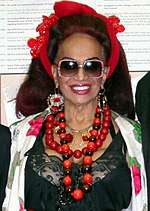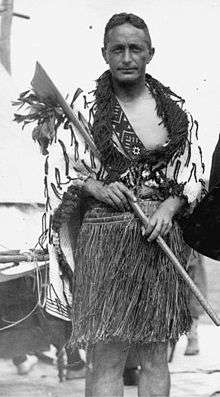Taumarunui
Taumarunui is a small town in the King Country of the central North Island of New Zealand. It is on an alluvial plain set within rugged terrain on the upper reaches of the Whanganui River, 65 km south of Te Kuiti and 55 km west of Turangi. It is under the jurisdiction of Ruapehu District and Manawatū-Whanganui region.
Taumarunui | |
|---|---|
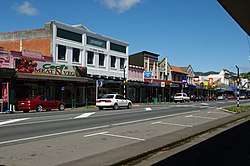 Hakiaha Street in 2009 | |
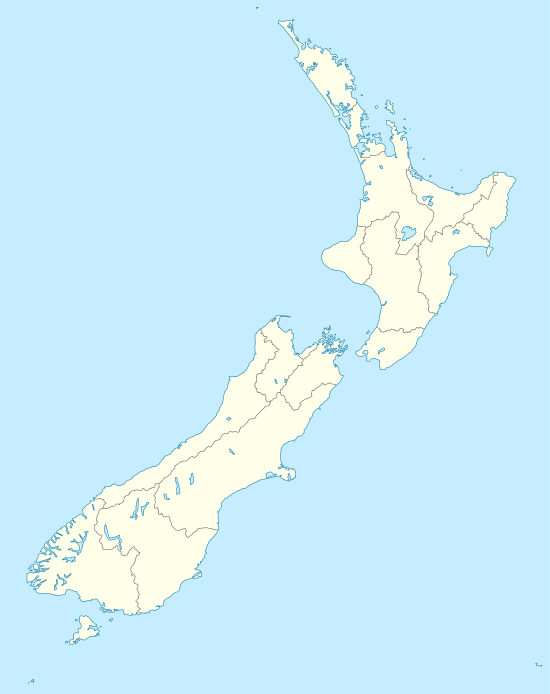 Taumarunui | |
| Coordinates: 38°53.0′S 175°15.7′E | |
| Country | |
| Region | Manawatū-Whanganui |
| Territorial authority | Ruapehu District |
| Population (June 2019)[1] | |
| • Total | 4,660 |
| Postcode(s) | 3920 |
| Area code(s) | 07 |
Its population is 4,503 (2013 census, this is down 11% from the 2006 census), making it the largest centre for a considerable distance in any direction. It is on State Highway 4 and the North Island Main Trunk railway.
The name Taumarunui is reported to be the dying words of the Māori chief Pehi Turoa – taumaru meaning screen and nui big, literally translated as Big Screen,[2] being built to shelter him from the sun, or more commonly known to mean – "The place of big shelter". There are also references to Taumarunui being known as large sheltered location for growing kumara.
In the 1980s publication Roll Back the Years there are some details on how Taumarunui got its name.[3] Extract: "According to Frank T Brown, who wrote in the Taumarunui Press in 1926, the name Taumarunui is closely connected with the arrival of and conquering of that portion of the King Country by the Whanganui River natives during the 18th century . . . The war party that succeeded in capturing the principal pa and taking prisoner the chief of the district was headed by "Ki Maru". His warriors, to show their appreciation of his prowess and the honour of the victory, acclaimed him "Tau-maru-nui", which means "Maru the Great", or "Maru the Conqueror", that name was taken for the district and has been used ever since."
History and culture
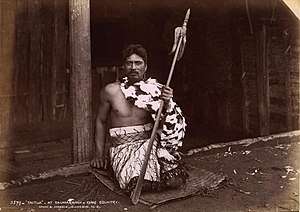
Taumarunui was originally a Maori settlement at the confluence of the Ongarue River with the Whanganui, important canoe routes linking the interior of the island with the lower Whanganui River settlements. Some places, notably the valley of the Pungapunga Stream, which joins the upper Whanganui near Manunui, were celebrated for the size and quality of totara, and large canoes were built there. The area is a border area between a number of iwi including Whanganui, Ngāti Maniapoto and Ngāti Tūwharetoa, who lived together in relative harmony.[4]
Late in December 1843 Bishop Selwyn travelled from the district south of Taupo to a point on the Whanganui River about six miles downstream from Taumarunui and thence continued his journey to the coast by canoe. Towards the end of 1869 Te Kooti was at Taumarunui before his march through the western Taupo district to Tapapa. In the early 1880s the first surveys of the King Country commenced and by the early 1890s the Crown had begun the purchase of large areas of land.
In 1874 Alexander Bell set up a trading post, and became the first European settler. The town has a road called Bell Road.
During the New Zealand Wars a resident named William Moffatt manufactured and supplied Maori with a coarse kind of gunpowder. He was afterwards expelled from the district. Despite warnings he returned in 1880, ostensibly to prospect for gold, and was executed.
The Whanganui River long continued to be the principal route serving Taumarunui. Traffic was at first by Maori canoe, but by the late 1880s regular steamship communication was established. Taumarunui Landing (Image) was the last stop on Alexander Hatrick's steam boat service from Wanganui. The river vessels maintained the services between Wanganui and Taumarunui until the late 1920s, when the condition of the river deteriorated.
Later Taumarunui gained importance with the completion of the North Island Main Trunk line in 1908–09 (celebrated in a ballad by Peter Cape about the station refreshment room). The line south of Taumarunui caused considerable problems due to the terrain, and has several high viaducts and the famous Raurimu Spiral. The Stratford–Okahukura Line to Stratford connected just north of Taumarunui. In more recent times, the town's economy has been based on forestry and farming. It has gained in importance as a tourism centre, especially as an entry point for voyagers down the scenic Wanganui River and as the possessor of a high quality golf course.
Timeline
1800s
- 1862, 8/9 February – James Coutts Crawford visits, was given a number of old songs and "various accounts of the taniwha, one of whom we were told overthrew the Wangaehu bridge."[5]
- 1864 – Boundaries of the King Country drawn and European settlement is prohibited.
- 1869 – Te Kooti in Taumarunui.[6]
- 1871 – Thomas McDonnell in area following up on reports of gold. Claimed to have found goldbearing quartz in the creeks of 'Taurewa' .
- 1874 – Alexander Bell set up a trading post, and became the first European settler.[7]
- 1880 – Moffatt and Henaro travel to the village of Matahaura, where William Moffatt is subsequently executed at Matapuna.[8]
- 1883 – John Rochford's survey party start surveying the rail route through the King Country.[9]
- 1884 – Prohibition to European settlement lifted. Alcohol prohibition established.
- 1885 – Photographer Alfred Burton, artist Edward Payton[10] and surveyor John Rochford[11] tour Te Rohe Pōtae along with time in Taumarunui.[12]
- 1885, 10 Dec – First post office opened in Taumarunui (under the name 'Taumaranui') as part of the Hamilton Postal District,[13] closes 1887.[14]
1900s
.jpg)
- 1900 – town-to-be reportedly held only 13 European males.[15] Another report said 40 or 50 members of Ngāti Hau and Mr Bell.[16]
- 1901 – Railways line joining Te Kuiti to Taumarunui opened.
- 1903 – Railway line passes through Taumarunui, and Taumarunui Railway Station opened on 1 December 1903 and Matapuna on 22 June 1903.
- 1904 – First European child is born in township.
- 1904 – £10,000 houseboat built then floated to Ohura river junction. In 1927 this is transferred down river to Retaruke River junction where it was destroyed by fire in 1933.
- 1906 – Native town council set up: Hakiaha Tawhiao, J.E.Ward (Interpreter), J.Carrington. E.W.Simmons, A.J.Langmuir (Chairman), J.E.Slattery.
- 1906, 14 Sep – First issue of the Taumarunui Press.
- 1907 – First hospital erected, 5 beds.
- 1908–09 – North Island Main Trunk opened to through Auckland-Wellington trains from 9 November 1908, with the first NIMT express trains from 14 February 1909.
- 1908–11 William Thomas Jennings elected Member of Parliament for Taumarunui electorate
- 1910 – Borough of Taumarunui proclaimed.
- 1910 – Kaitieke Co-op Dairy Co. formed.[17][18]
- 1910 – George Henry Thompson defeated Rev John E. Ward (166 to 143 votes) to become the first borough council mayor.
- 1912 – Population: Males: 641; Females: 487 – Note: 1912 census did not include a count of Maori.
- 1912 – Township started getting water supply from Waitea Creek, just south of Piriaka. Project cost £13,000. Pipeline 8 miles long.
- 1913 – William Henry Wackrow – Mayor[19]
- 1913, 22 Jul – First reported cases of Smallpox in district.[20]
- 1911–14 Charles Wilson elected Member of Parliament
- 1914 – Taumarunui gas supply begins
.jpg)
1914–18 – World War I
- 1914–19 – William Thomas Jennings re-elected Member of Parliament
- 1915 – Taumarunui Hospital Board formed, 30 beds.
- 1915 – Only a single car in town.[21]
- 1915–1917 – Mayor: G.S. Steadman.[22]
- 1916 – Census: 3,021 (Taumarunui & Manunui)[23]
- 1917 – Tuku Te Ihu Te Ngarupiki, Chief of Rangatahi, dies in Matapuna near Taumarunui aged 97.
- 1917–1919 – Mayor: A.S. Laird.[24]
- 1919–1923 – Mayor: G.S. Steadman.[25]
- 1923–1925 – Mayor: C.C. Marsack.[26]
- 1924 – The Piriaka Power Station was built to supply electricity to Taumarunui.[27]
- 1925–1929 – Mayor: G.E. Manson.[28]
- 1928 – Four thousand bales of wool shipped down river
- 1929–1944 – Mayor: Cecil Boles.[29]
- 1932 – Stratford–Okahukura Line completed.
- 1939 – Hatricks's steamer ceased running, final section of the journey having been done by coach from Kirikau landing since 1927.
.jpg)
1939–1945 – World War II
- 1941 – Cosmopolitan Club established with Father Conboy as first president.
- 1944–1947 – W.S.N. Campbell.[30]
- 1947–1953 – Mayor: D.H. Hall.[31]
- 1951 – Census: 3,220
- 1952 – Kaitieke County and Ohura County amalgamated with Taumarunui County.
- 1953–1956 – Mayor: David C. Seath – later Member of Parliament for the King Country
- 1956 – Mayor: Frank D. House – later Taumarunui High School governor.
- 1956 – Census: 3,341
- 1961 – Census: 4,961
- 1962 – The King Country Electric Power Board commissioned its Kuratau Power Station.[32]
- 1966 – 1 October, 6:00pm – King Country Radio 1520AM with the call sign 1ZU first broadcasts from Taumarunui.
- 1968 – N.Z. Sportsmen's dinner – attended by Fred Allen, Peter Snell, Waka Nathan, Colin Meads, Bob Skelton, Taini Jamieson, Tilley Vercoe, Ivan Grattan, Bill Wordley, Don Croot, Trevor Ormsby, Hine Peni and Sonny Bolstad.[33]
- 1971 – Additional generator to the Piriaka Power Scheme[34]
- 1976, Oct 4 – Daniel Houpapa shot by Armed Offenders Squad after he fires at an officer[35]
- 1981 – Census: 6,540, Full-time in labour force: 2,727[36]
- 1986 – Census: 6,468, Full-time in labour force: 2,514
- 1988 – Taumarunui District Council formed.
Town Mayors immediately prior to 1988 include: Charles Binzegger, Les Byars and Terry Podmore.[37]
- 1989, Nov 1 – Taumarunui District Council merged into Ruapehu District Council.[38]
- 1991 – Census: 6,141, Full-time in labour force: 1,935
- 1996 – Census: 5,835, Full-time in labour force: 1,438
- 1997/98 – AFFCO Holdings freezing works closes.
2000s
- 2001 – Census: 5,139
- 2005/06 – Taumarunui Milk Co-op closes – 95 years after the original Kaitieke Co-op Dairy Co. was opened.[39][40][41]
- 2006 – Census: 5,052[42]
- 2009, Nov – Stratford–Okahukura Line mothballed.[43]
- 2010, Mar 31 – King Country Radio 1512AM & 92.7FM with the call sign 1ZU goes off air.
- 2012, Jun 25 – Taumarunui Station passenger stop dropped from Northern Explorer's schedule.[44]
- 2013 – Census: 4,500[45]
Marae
There are a number of marae in the Taumarunui area, affiliated with local iwi and hapū:
- Kimihia Marae is affiliated with Ngāti Te Wera
- Morero Marae and Hauaroa is affiliated with Ngāti Hekeawai and the Ngāti Hauā hapū of Ngāti Hāuaroa and Ngāti Reremai
- Ngāpuwaiwaha Marae and Te Taurawhiri a Hinengākau is affiliated with the Ngāti Hauā hapū of Ngāti Hāua and Ngāti Hāuaroa
- Te Peka Marae is affiliated with the Ngāti Hauā hapū of Ngāti Hekeāwai
- Petania Marae and Hinemihi meeting house are affiliated with the Ngāti Maniapoto hapū of Hinemihi, Parewaeono and Rōrā, and the Ngāti Tūwharetoa hapū of Ngāti Hinemihi
- Tū Whenua Marae and Tū Whenua meeting house is affiliated with the Ngāti Maniapoto hapū of Mangu, Rewa and Tupu
- Whānau Maria Marae and Whānau Maria meeting house is affiliated with the Ngāti Hauā hapū of Ngāti Hāua
- Wharauroa Marae and Hikurangi meeting house is affiliated with the Ngāti Maniapoto hapū of Hinemihi, Pahere and Rangatahi, with the Ngāti Hauā hapū of Ngāti Hinewai, Ngāti Hāua and Ngāti Wera/Tuwera, with Ngāti Hinewai, and with Ngāti Rangatahi.[46][47]
Locality
Township and borough
On State Highway 4 south of Taumarunui are the villages of Manunui, Piriaka, Kakahi, Ōwhango, Raurimu and then National Park. To the north are the school and truck stop of Mapiu.
Taumarunui County
Taumarunui County was defined in the Waikato and King-country Counties Act 1922,[48] this statute states:
ALL that area of land in the Auckland and Wellington Land Districts bounded towards the north generally by the Waitomo and Taupo Counties (as described in the Third and Ninth Schedules to this Act respectively); on the east generally by Lake Taupo and Taupo County; on the south generally by the middle of the Wanganui River; on the west generally by the Ongarue River to the Waitomo County. the place of commencement: excluding the Borough of Taumarunui.
Then subsequently in 1952 the Kaitieke County and the Ohura County were amalgamated with a new Taumarunui County.
Then in 1988 the Taumarunui District Council was formed only to be replaced in 1989 as it was merged into the now Ruapehu District Council.
Demographics
Taumarunui, including the surrounding areas of Tarrangower, Sunshine-Hospital Hill and Manunui, had a population of 4,503 at the 2013 New Zealand census, a decrease of 549 people since the 2006 census. There were 2,139 males and 2,364 females.[49][50][51][52] 62.1% were European/Pākehā, 50.9% were Māori, 2.8% were Pacific peoples and 3.0% were Asian.[53][54][55][56]
Community institutions
Ngāpuwaiwaha marae is on Taumarunui Street; its main hapū are Ngāti Haua and Ngāti Hauaroa of the iwi Te Āti Haunui-a-Pāpārangi.[57]
Taumarunui has many societies and community organizations. It has a Cosmopolitan Club and RSA, a Lodge of the Freemasons as well as Taumarunui Lodge NZ № 12 of the Royal Antediluvian Order of Buffaloes Grand Council. This Lodge of the Buffaloes was established sometime in the mid-late 1920s and thus predates the introduction of the Mighty NZR KA class steam locomotives that became the hallmark of NIMT Rail Transport of the forties, fifties and sixties.
Climate
Under the Köppen, Taumarunui has an Oceanic climate:(Cfb). Due to location, low altitude and Geography surroundings, Taumarunui is more liable to warm to hot summers than other central North Island centres and in winter Taumarunui is cold and frosty. Rainfall yearly is 1,449 mm (57.047244 in). Annual sunshine yearly is 1822 hrs. In June 2002 Taumarunui recorded just 27 hrs of sun this lowest of the whole country beating the old record at Invercargill with 35 hrs in June 1935.[58] The lowest temperature recorded in Taumarunui, −6.8 °C, was in July 2010.[59]
| Climate data for Taumarunui, New Zealand | |||||||||||||
|---|---|---|---|---|---|---|---|---|---|---|---|---|---|
| Month | Jan | Feb | Mar | Apr | May | Jun | Jul | Aug | Sep | Oct | Nov | Dec | Year |
| Average high °C (°F) | 24.8 (76.6) |
25.0 (77.0) |
23.0 (73.4) |
19.6 (67.3) |
15.7 (60.3) |
12.9 (55.2) |
12.5 (54.5) |
14.0 (57.2) |
15.9 (60.6) |
18.3 (64.9) |
20.7 (69.3) |
23.0 (73.4) |
18.7 (65.7) |
| Daily mean °C (°F) | 18.4 (65.1) |
18.4 (65.1) |
16.7 (62.1) |
13.4 (56.1) |
10.2 (50.4) |
8.0 (46.4) |
7.3 (45.1) |
8.7 (47.7) |
10.7 (51.3) |
12.8 (55.0) |
14.9 (58.8) |
17.0 (62.6) |
13.0 (55.4) |
| Average low °C (°F) | 12.0 (53.6) |
11.8 (53.2) |
10.5 (50.9) |
7.3 (45.1) |
4.6 (40.3) |
3.1 (37.6) |
2.1 (35.8) |
3.4 (38.1) |
5.4 (41.7) |
7.4 (45.3) |
9.2 (48.6) |
11.0 (51.8) |
7.3 (45.1) |
| Average precipitation mm (inches) | 107.1 (4.22) |
81.3 (3.20) |
91.8 (3.61) |
95.6 (3.76) |
132.6 (5.22) |
136.6 (5.38) |
141.6 (5.57) |
130.0 (5.12) |
140.0 (5.51) |
129.4 (5.09) |
126.6 (4.98) |
137.0 (5.39) |
1,449.6 (57.07) |
| Mean monthly sunshine hours | 220.4 | 194.5 | 167.2 | 129.7 | 100.8 | 71.5 | 94.9 | 120.4 | 140.1 | 168.6 | 192.3 | 210.2 | 1,822.6 |
| Source: climate-charts.com[60] | |||||||||||||
Education
Taumarunui High School is a co-educational state secondary school for Year 9 to 13 students,[61] with a roll of 299 as of March 2020.[62]
The town has three primary schools for Year 1 to 8 students: Taumarunui Primary School,[63] with a roll of 132,[64] Tarrangower School,[65][66] with a roll of 36,[67] and Turaki School,[68][69] with a roll of 188.[70]
St Patrick's Catholic School is a co-educational state-integrated Catholic primary school for Year 1 to 8 students,[71] with a roll of 35.[72]
Notable people
- T.J. Meredith – great-grandson of Theodore of Corsica, joined Royal Navy age 14, CSS Louisiana in 1862 American Civil War, under General Cameron New Zealand Wars, Waikato Mounted Rifles World War I, before coming the proprietor of Taumarunui's Meredith House with wife Margaret Lovett.[73]
Students of Taumarunui High School
- Prof. James L. Beck[74] – Professor of Engineering and Applied Science, California Institute of Technology.
- Prof. John C. Butcher ONZM [75] – Honorary Research Professor, Dept. of Mathematics, University of Auckland.
- Ben Fouhy,[76] world champion kayaker.
- Marc and Todd Hunter from the band Dragon.
- Ivan Mercep, 2008 recipient of the New Zealand Institute of Architects Gold Medal.
- Jenny Ludlam – actress.
Born in Taumarunui
- 1914 – Wiremu Hakopa Toa Te Awhitu SM (1914–1994) was the first Māori to be ordained a Catholic priest.
- 1934 – Ian Barker, solicitor, judge, and legal scholar[77]
- 1935 – Don Selwyn, actor, director, stage and screen, Ngāti Kuri and Te Aupōuri (1935–2007) [78]
- 1936 – Carmen Rupe (né Trevor Rupe, 1935–15 December 2011) – Wellington personality (mayoral candidate (1977), drag queen, cafe owner and brothel keeper).[79][80][81]
- 1939 – David Penny, theoretical biologist.[82]
- 1945 – Carole Shepheard, artist.
- 1951 – Joe Karam, rugby union player, researcher and investigator for David Bain's legal team.
- 1952 – Ian Ferguson, Olympic canoer.
- 1952 – Max Takuira Matthew Mariu SM (1952–2005), Auxiliary Catholic Bishop of Hamilton (1988–2005), first Māori to be ordained a Catholic bishop.
- 1953 – Marc Hunter, lead singer of Dragon.
- 1955 – Mahinārangi Tocker, singer.
- 1956 – Len Brown Mayor of Auckland
- 1958 – Jillian Smith, field hockey player.
- 1958 – Lindsay Crocker, cricketer.
- 1963 Timothy J. Sinclair, political scientist at the University of Warwick in England.
- 1971 – Kyle Chapman, former leader of the New Zealand National Front
- 1973 – Chris McCormack World Champion Ironman Triathlete (2007, 2010).
Resident and New Years Honours recipients
- 1956 – OBE – Pateriki Joseph Hura – For services to the Māori people, especially as a member of the Board of Maori Affairs.
- 1957 – MBE – Mrs Catherine Goodsir – For social welfare services
- 1958 – MBE – Mrs Rumatiki Wright of Raetihi. For services to the Māori people, especially as Senior Lady Māori Welfare Officer
- 1961 – OBE – Pei Te Hurinui Jones – For services to the Māori people.
- 1967 – MBE – James Dempsey J.P. – chairman of the Taumarunui County Council.
- 1970 – BEM – Eric Raymond Clark – For services to the community and interest in the education of the Māori people.
- 1974 – BEM – Arthur Tukiri Anderson – For services to the Returned Services Association and the community
- 1979 – KBE – Hepi Hoani Te Heuheu – For services to the Māori people and community.
- 1995 – CBE – Alexander Phillips QSM – For services to the Māori people.
- 1998 – MNZM – John Stacey Black J.P. – For services to the community.
- 2000 – QSM – Jean Bassett – For Community Service
- 2001 – QSM – Mrs Verna Lenice Warner J.P. – For Community Service
- 2002 – MNZM – Mrs Nansi Whetu Dewes – For services to Māori and the community
- 2002 – QSM – Barry David FISHER, of Taumarunui. Chief Fire Officer, Taumarunui Volunteer Fire Brigade, New Zealand Fire Service – For Services to the community
- 2003 – QSM – Leonard Patrick Harwood – For Public Services
- 2007 – QSM – Mr William Vernon McMinn – For services to music.
- 2009 – MNZM – Ngarau Tarawa – For services to Māori and community education
- 2010 – QSM – Mrs Lorraine Ivy Edwards J.P. – For services to the community.
- 2012 – MNZM – Ian Trevor Corney – For services to agriculture
- 2013 – ONZM – Susan May Morris – For services to local government.
Notes
- "Subnational Population Estimates: At 30 June 2019". Statistics New Zealand. 22 October 2019. Retrieved 11 January 2020.
- "1000 Māori place names". New Zealand Ministry for Culture and Heritage. 6 August 2019.
- "How Taumarunui got its name" (PDF). Roll Back the Years. p. 9. Retrieved 15 March 2009.
- "TAUMARUNUI – Te Ara: The Encyclopedia of New Zealand". Teara.govt.nz. 22 April 2009. Retrieved 23 October 2013.
- "Recollections of travel in New Zealand and Australia : Crawford, James Coutts : Free Download & Streaming : Internet Archive". Archive.org. 10 March 2001. Retrieved 23 October 2013.
- "Papers Past — Colonist — 18 January 1870 — IMPORTANT FROM WAIKATO". Paperspast.natlib.govt.nz. Retrieved 23 October 2013.
- "The "Father of Taumarunui." | NZETC". Nzetc.victoria.ac.nz. 1 August 1932. Retrieved 23 October 2013.
- "Papers Past — Evening Post — 12 November 1880 — FURTHER DETAILS. [UNITED PRESS ASSOCIATION.] Wanganui, This Day". Paperspast.natlib.govt.nz. Retrieved 23 October 2013.
- "The Trail of Adventure — Pioneer Survey of the North Island Main Trunk Railway". The New Zealand Railways Magazine. 8 (7). 1 November 1933. Retrieved 14 January 2015.
- Platts, Una (1980). "PAYTON, Edward William 1859–1944". Nineteenth Century New Zealand Artists: A Guide & Handbook. Christchurch: Avon Fine Prints. Retrieved 18 January 2015.
- "ROCHFORT, John". Te Ara: The Encyclopedia of New Zealand. 23 April 2009. Retrieved 18 January 2015.
- "Alfred Burton and Edward Payton, 1885 – King Country region". Te Ara: The Encyclopedia of New Zealand. 26 November 2013. Retrieved 18 January 2015.
- "Taumarunui Post Office". Register of Historic Places. Heritage New Zealand. Retrieved 15 September 2013.
- Staff reporter – Taumarunui. "Old Post Office to Make Way for New Court House" (29 December 1966 ed.). Taumarunui: clipping. Cite journal requires
|journal=(help) - Craig 1990, 1900 p.143
- "MAIN TRUNK RAILWAY. AUCKLAND STAR". paperspast.natlib.govt.nz. 3 December 1900. Retrieved 26 March 2020.
- "Farm Notes". Ohinemuri Gazette. XXI (2639). 9 May 1910. p. 3. Retrieved 11 February 2013.
- "Kaitieke Co-op Dairy Co". Auckland Star. XLIX (193). 14 August 1918. p. 6. Retrieved 11 February 2013.
- "Taumarunui Hospital". The New Zealand Herald. L (15325). 11 June 1913. p. 4. Retrieved 18 January 2015.
- "Outbreaks Near Taumarunui". Wanganui Chronicle (12889). 23 July 1913. p. 5. Retrieved 18 January 2015.
- Craig 1990, First car p.143
- Craig 1990, 1915–1917 p.143
- "North Island influenza death rates | NZHistory, New Zealand history online". Nzhistory.net.nz. Retrieved 23 October 2013.
- Craig 1990, 1917–1919 p.143
- Craig 1990, 1919–1923 p.143
- Craig 1990, 1923–1925 p.143
- "Piriaka Power Scheme". King County Energy. Archived from the original on 28 September 2011.
- Craig 1990, 1925–1929 p.143
- Craig 1990, 1929–1944 p.143
- Craig 1990, 1944–1947 p.143
- Craig 1990, 1947–1953 p.143
- "KCE celebrates 50th anniversary of Kuratau Power Station | Scoop News". Scoop.co.nz. 10 December 2012. Retrieved 23 October 2013.
- "Taumarunui Queen Carnival". Te Ao Hou THE MAORI MAGAZINE. Department Maori and Islands Affairs. September–November 1968. Retrieved 10 June 2008.
- ":::King Country Energy:::". Home.xtra.co.nz. Retrieved 23 October 2013.
- NZPA (23 October 2008). "Chronology of fatal shootings by NZ police". The New Zealand Herald. Retrieved 9 October 2009.
- "Appendix II: Taumarunui: Farming-Community Linkages". Ministry of Agriculture and Forestry (New Zealand). Retrieved 23 October 2013.
- Craig 1990, pre 1988 mayors p.143
- "About Council". Ruapehu District Council. Archived from the original on 22 January 2010.
- "About Us at King Country Driver Training". Kingcountrydrivertraining.co.nz. Retrieved 23 October 2013.
- "Certificate of Incorporation : TAUMARUNUI MILK CO-OPERATIVE (1972) LIMITED : 193624". Business.govt.nz. Retrieved 23 October 2013.
- "KAITIEKE CO-OP. DAIRY CO". Auckland Star. XLIX (193). 14 August 1918. p. 6. Retrieved 11 February 2013.
- "Our District – Facts and Figures". Ruapehu District Council. Archived from the original on 28 January 2010.
- Dearnaley, Mathew (9 November 2009). "Line's mothballing sets off alarm bells". The New Zealand Herald. Retrieved 10 November 2009.
- "Dash to catch the last train". Manuwatu Standard. 25 June 2012. Retrieved 11 February 2013.
- Census 2013
- "Te Kāhui Māngai directory". tkm.govt.nz. Te Puni Kōkiri.
- "Māori Maps". maorimaps.com. Te Potiki National Trust.
- "Waikato and King-country Counties Act 1921 (12 GEO V 1921 No 64)". Nzlii.org. Retrieved 23 October 2013.
- 2013 Census QuickStats about a place : Taumarunui Central
- 2013 Census QuickStats about a place : Tarrangower
- 2013 Census QuickStats about a place : Sunshine-Hospital Hill
- 2013 Census QuickStats about a place : Manunui
- 2013 Census QuickStats about a place (Cultural diversity) : Taumarunui Central
- 2013 Census QuickStats about a place (Cultural diversity) : Tarrangower
- 2013 Census QuickStats about a place (Cultural diversity) : Sunshine-Hospital Hill
- 2013 Census QuickStats about a place (Cultural diversity) : Manunui
- "Ngāpuwaiwaha". Māori Maps. Retrieved 1 December 2015.
- "Climate extremes". NIWA. Retrieved 18 January 2015.
- Dickison, Michael (14 July 2010). "Mercury plunges to record lows". The New Zealand Herald.
- "Taumarunui, New Zealand". climate-charts.org. Retrieved 6 January 2015.
- "Taumarunui High School Ministry of Education School Profile". educationcounts.govt.nz. Ministry of Education.
- "Taumarunui High School Education Review Office Report". ero.govt.nz. Education Review Office.
- "Taumarunui Primary School Ministry of Education School Profile". educationcounts.govt.nz. Ministry of Education.
- "Taumarunui Primary School Education Review Office Report". ero.govt.nz. Education Review Office.
- "Tarrangower School Official School Website". tarrangower.school.nz.
- "Tarrangower School Ministry of Education School Profile". educationcounts.govt.nz. Ministry of Education.
- "Tarrangower School Education Review Office Report". ero.govt.nz. Education Review Office.
- "Turaki School Official School Website". turakiprimary.school.nz.
- "Turaki School Ministry of Education School Profile". educationcounts.govt.nz. Ministry of Education.
- "Turaki School Education Review Office Report". ero.govt.nz. Education Review Office.
- "Ministry of Education School Profile". educationcounts.govt.nz. Ministry of Education.
- "Education Review Office Report". ero.govt.nz. Education Review Office.
- Craig 1990, T.J. Meredith p.147
- "James L. Beck". Its.caltech.edu. Retrieved 23 October 2013.
- "John Butcher's Homepage". Math.auckland.ac.nz. Retrieved 23 October 2013.
- "Ben Fouhy : Words". Benfouhy.com. Retrieved 23 October 2013.
- Lambert, Traue & Taylor 1991, p. 31.
- "The Arts Foundation : Don Selwyn – Biography". Thearts.co.nz. Retrieved 18 January 2015.
- Dastgheib, Shabnam (9 October 2009). "Birthday girl Carmen hits town". The Dominion Post. Retrieved 16 December 2011.
- O'Keefe and Fox 2008, p. 249.
- "Colourful Wellington identity Carmen dies". The Dominion Post. 15 December 2011. Retrieved 15 December 2011.
- "Professor Emeritus joins prominent US Academy". Massey University. Retrieved 30 January 2019.
References
- Craig, Dick (1990). The King Country. Waitomo: Waitomo News.
- Lambert, Max; Traue, James Edward; Taylor, Alister (1991). Who's Who in New Zealand, 1991 (12th ed.). Auckland: Octopus. Retrieved 29 July 2015.
- O'Keefe, Tracie; Fox, Katrina (6 June 2008). "Chapter 24: Madam Carmen – Carmen Rupe". Trans People in Love. Routledge. ISBN 978-0-7890-3572-1.
External links
| Wikimedia Commons has media related to Taumarunui. |
- Taumarunui website
- Local History
- Taumarunui High School
- River Boat Landings
- Peter Cape's song, "Taumarunui on the Main Trunk Line"
